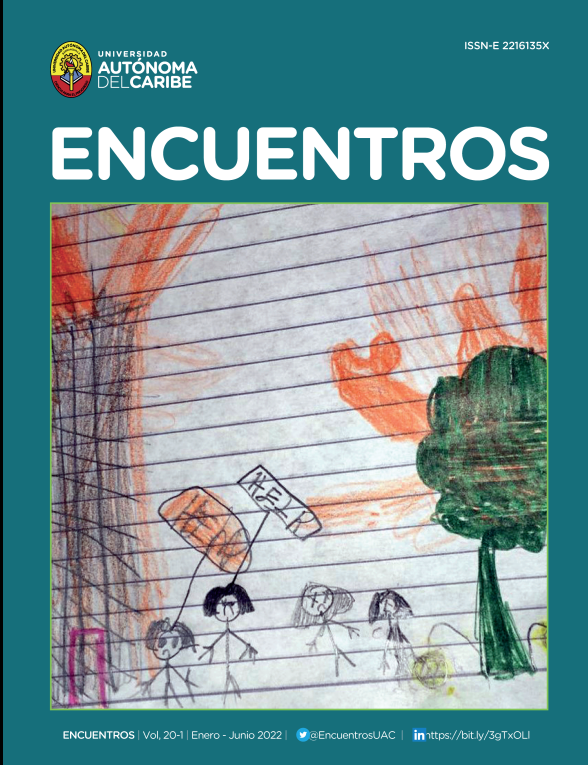The representation of identity on public television, a study of the miniseries ‘Déjala morir’
DOI:
https://doi.org/10.15665/encuen.v20i01.2114Abstract
This paper answer to how meanings, produce by audience and producer of biographic miniseries Déjala morir - which airs on the public television station Telecaribe that tells the story of Juana Emilia Herrera - converge and diverge. To achieve it, four methods were applied to study: a textual analysis of the miniseries, an in-depth interview for its creator, a focus group with the audience and a qualitative content analysis of comments made on Facebook profiles of El Heraldo, and El Espectador when users who watch the series publish their opinions about it. As representative results, three key categories were found: the representation of the Caribbean through the audiovisual, the Caribbean woman, and the critical audience. Finally, it is established that the audience finds a representation of its territory, which the protagonist represents the values and talent of ‘The Emilia Girl’ and, finally, is evidenced by a critical audience that assumes a divergent posture with television productions Commercial and convergent with the content issued in Déjala morir.
References
Agudelo, M. (2003). La costeña y el cachaco. Colombia: Canal RCN.
Araújo, L. F. (2015). A Negação do Brasil: O Negro na Telenovela Brasileira, 17(20), 13–26.
Arthurs, J. (2008). Cultural Studies: Feminist Popular Culture. In The International Encyclopedia of Communication
(Donsbach,). Blackwell Publishing. Retrieved from http://www.communicationencyclopedia.com/subscriber/tocnode.html?id=g9781405131995_yr2014_chunk_g978140513199524_ss106-1
Castelló, E. (2010). Dramatizing proximity: Cultural and social discourses in soap operas from production to reception.
European Journal of Cultural Studies, 13(2), 207–223. http://doi.org/10.1177/1367549409352274
Dunn, J. C. (2016). Going to Work at the Moonlite Bunny Ranch. Cultural Studies. Critical Methodologies, 16(6),525–535. http://doi.org/10.1177/1532708616655822
Grossberg, L. (2012). Estudios culturales en tiempo futuro. Buenos Aires: Siglo XXI editores.
Gutiérrez, M. F. (2017). “Déjala morir”, la historia de “La niña Emilia” que revive la televisión regional. El Espectador. Bogotá.
Gutiérrez-González, C. (2019). La relación entre los creativos independientes de la televisión pública y la audiencia infantil. Anagramas Rumbos y Sentidos de La Comunicación, 18(35), 39–55. https://doi.org/10.22395/angr. v18n35a3
Gutiérrez-González, C., & González Pardo, R. (2021). Análisis de las publicaciones en “televisión pública” indexadas en Web of Science (2001-2019). Historia y Comunicación Social, 26(1), 291–305. https://doi.org/10.5209/ hics.66254
Hall, S. (1997). Stuart Hall. Representation & the media. Media Education Foundation. UK.
Hall, S. (2011). Introducción: ¿quién necesita “identidad”? In S. Hall & P. du Gay (Eds.), Cuestiones de identidad cultural (pp. 13–39). Buenos Aires: Amorrortu Editores.
Hall, S. (2012). Encoding/Decoding. In M. Durham & D. Kellner (Eds.), Media and Cultural Studies: Keywords (2nd ed, pp. 137–144). UK: John Wiley & Sons.
Kidd, J. (2016). Representation. London & New York: Routledge.
Lasorsa, D. (2008). Stereotypes. In The International Encyclopedia of Communication (Donsbach W). Blackwell Publishing. Retrieved from http://ezproxy.uninorte.edu.co:2477/subscriber/uid=4867/ tocnode?id=g9781405131995_yr2014_chunk_g978140513199524_ss106-1
Lemish, D. (2012). Gender: Representation in the Media. In The International Encyclopedia of Communication (Donsbach W). Blackwell Reference Online. Retrieved from http://www.communicationencyclopedia.com/ subscriber/tocnode.html?id=g9781405131995_yr2014_chunk_g978140513199512_ss8-1
McKee, A. (2003). What is textual analysis? Textual Analysis: A Beginner’s Guide, 1–33. https://doi.org/http://dx.doi. org/10.4135/9780857020017.n1
McRobbie, A. (2008). Young women and consumer culture. Cultural Studies, 22(5), 531–550. http://doi. org/10.1080/09502380802245803
Miller, T. (2017). Hall, Stuart. In Oxford Research Encyclopedia of Communication. Oxford University Press. Retrieved from http://communication.oxfordre.com/view/10.1093/acrefore/9780190228613.001.0001/acrefore-9780190228613-e-46.
Moncada, H., & Cáceres, J. (2014). La playita. Colombia: Canal RCN.
Ochoa, C. M. (2014). Bazurto. Colombia: Caracol Televisión.
Pinzón, J. C., & Cook, C. (2017). Polvo carnavalero. Colombia: Caracol Televisión.
Rayo, J., & Bierdman, A. (2017). Los Morales. Colombia: Caracol Televisión.
Revista Semana. (2017). La serie de Telecaribe que mostró el potencial de los canales regionales. Retrieved from http://www.semana.com/cultura/articulo/dejala-morir-la-exitosa-serie-de-telecaribe/520493
Ribero, M. (2010). Chepe fortuna. Colombia: Canal RCN.
Ruíz-Navarro, C. (2017). Caras pintadas. El Heraldo. Barranquilla. Retrieved from https://www.elheraldo.co/ columnas-de-opinion/caras-pintadas-357435
Salgado, A. (2011). El Joe, la leyenda. Colombia: Canal RCN.
Salgado, A. (2017). Déjala Morir. Colombia: Telecaribe.
Sistema Único de Información Normativa. (1984). Decreto 3100 de 1984. Retrieved May 21, 2017, from http://www. suin-juriscol.gov.co/viewDocument.asp?id=1513093
Solano, L. (2017). “Déjala Morir”, la miniserie de la Niña Emilia que batió récords de audiencia. El Heraldo. Barranquilla. Retrieved from https://www.elheraldo.co/entretenimiento/dejala-morir-la-miniserie-de-la-ninaemilia-que-batio-records-de-audiencia-334759
Somani, I. S., & Doshi, M. J. (2016). “That’s Not Real India.” Journal of Communication Inquiry, 40(3), 203–231. http://doi.org/10.1177/0196859916638648
Straubhaar, J. D. (1991). Beyond media imperialism: Asymmetrical interdependence and cultural proximity. Critical Studies in Mass Communication, 8(1), 39–59. http://doi.org/10.1080/15295039109366779
Turnbull, S. (2010). Crime as entertainment: The case of the TV crime drama. Continuum, 24(6), 819–827. http://doi.org/10.1080/10304312.2010.510591
Uribe-Jongbloed, E., & Espinosa-Medina, H. D. (2014). A clearer picture: Towards a new framework for the study of cultural transduction in audiovisual market trades. Observatorio, 8(1), 23–48.
Downloads
Published
How to Cite
Issue
Section
License
Copyright (c) 2022 Carlos Gutierrez- González

This work is licensed under a Creative Commons Attribution-NonCommercial-NoDerivatives 4.0 International License.
Proposed Policy for Open Access Journals
Authors who publish in this journal agree to the following terms:
- Authors retain copyright and grant the journal the right of first publication, with the work registered under a Creative Commons Attribution License, which allows others to use the published work as long as the authorship and first publication in this journal are acknowledged.
- Authors can enter into additional contractual agreements for the non-exclusive distribution of the published version of the article (e.g., include it in an institutional repository or publish it in a book) as long as the first publication in this journal is acknowledged.
- Authors are allowed and encouraged to post their work online (e.g., on institutional or personal websites) before and during the submission process, as this can lead to productive exchanges and a greater and faster dissemination of the published work (see The Effect of Open Access).


